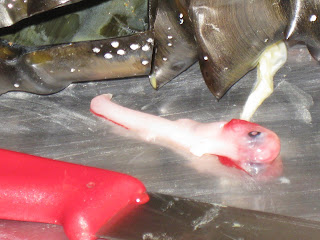









About 12 years ago I found a Port Jackson shark egg case on 'our' beach -- here on Phillip Island -- that contained an almost fully developed baby shark attached to an egg sack. It was a rare find and we never expected to discover another.
Yesterday, however, Doug found another Port Jackson egg case which looked and felt as if it contained something. Probably sand, we reasoned, yet we brought it home and cut it open in the laundry sink. And yes, another shark pup, but this time much earlier in its development. Doug christened him Simon and preserved him in methylated spirits.
So now Samuel and Simon sit side by side in their bottles; preserved.
PS
Both shark pups were dead when we cut open their case. When the female Port Jackson shark lays her eggs, she pushes each cork-screw shaped egg case (the outer surface looks like seaweed) into a rocky crevice, there to develop and finally emerge as an independent shark pup.













































